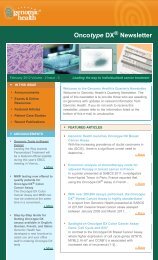Evolution of the 21-gene Assay Oncotype DX - Clinical Senology
Evolution of the 21-gene Assay Oncotype DX - Clinical Senology
Evolution of the 21-gene Assay Oncotype DX - Clinical Senology
You also want an ePaper? Increase the reach of your titles
YUMPU automatically turns print PDFs into web optimized ePapers that Google loves.
and fragmentation <strong>of</strong> RNA over time during storage, Cronin et al.<br />
managed to develop a robust, high-throughput, realtime, reversetranscriptase<br />
polymerase chain reaction (RT-PCR) analysis <strong>of</strong> formalinfixed<br />
paraffin-embedded (FFPE) tumour tissue that could also be used<br />
for archival tissue blocks. 3,4<br />
As a second step, 250 candidate <strong>gene</strong>s were selected from published<br />
literature, genomic databases and experiments based on DNA arrays<br />
performed on fresh-frozen tissue. Expression <strong>of</strong> <strong>the</strong>se <strong>gene</strong>s was<br />
measured by RT-PCR in tumour samples <strong>of</strong> 447 patients with nodenegative,<br />
oestrogen-receptor (ER)-positive breast cancer from three<br />
independent clinical studies. Individual clinical data and results <strong>of</strong> <strong>gene</strong><br />
expression analyses were correlated to identify prognostic <strong>gene</strong>s. 5–7<br />
The 16 <strong>gene</strong>s with <strong>the</strong> highest correlation to distant recurrence after<br />
10 years were selected for final model building and validation. 8<br />
The panel includes <strong>gene</strong>s associated with proliferation, invasion,<br />
ER, <strong>the</strong> human epidermal growth factor HER2neu and three o<strong>the</strong>r<br />
<strong>gene</strong>s (see Figure 1). 9 Relative expression <strong>of</strong> <strong>the</strong>se <strong>gene</strong>s is measured<br />
in relation to <strong>the</strong> average expression <strong>of</strong> five reference <strong>gene</strong>s. An<br />
algorithm was designed to calculate a numerical Recurrence Score<br />
(RS) ranging between 1 and 100 (see Figure 1). A low RS value<br />
corresponds to a low probability <strong>of</strong> distant recurrence at 10 years,<br />
whereas a higher score is associated with a higher probability.<br />
Validation <strong>of</strong> <strong>the</strong> Recurrence Score in<br />
Node-negative, ER-positive Breast Cancer<br />
The <strong>Oncotype</strong> <strong>DX</strong> assay validation study was conducted utilising tumour<br />
specimens from patients who had been prospectively enrolled within<br />
<strong>the</strong> NSABP B-14 study. 8 The B-14 study included 2,617 women with<br />
node-negative, ER-positive breast cancer treated with tamoxifen for five<br />
years. RT-PCR was successfully performed in 668 <strong>of</strong> 675 cases. In <strong>the</strong>se<br />
cases tumour blocks contained sufficient material to perform <strong>the</strong> test.<br />
The Kaplan-Meier estimate for distant recurrence at 10 years for <strong>the</strong><br />
corresponding patients was 15%, indicating a highly representative<br />
node-negative, ER-positive patient population. Based on <strong>the</strong> results<br />
<strong>of</strong> previous studies, three risk groups were defined: a low risk <strong>of</strong><br />
recurrence at 10 years after surgery for an RS



